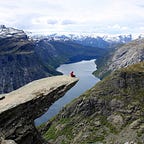The Sacred City of Anuradhapura
With only a few days left in Sri Lanka, I arrived in the ancient capital of Anuradhapura where I would be staying with locals. My host showed me around their wonderful house and welcomed me with a freshly baked delicious cake. Since I had more than enough time, I divided my Anuradhapura sojourn in two parts. First, I would visit the city and its UNESCO heritage monuments and then its environs.
It was a cloudy morning when I stepped out and walked from the residential neighbourhood towards the ancient sites. As I approached the entrance, a huge brick stupa peeped from behind a field of young paddy shoots. The dark reddish building stood out above the bright green ricefield. I entered the sacred city and saw Sri Lankan devotees lighting lamps near a Ficus religiosa tree.
This tree, also known as the Maha Bodhi tree, was brought here more than 2000 years ago by Sanghamitta, daughter of the great Buddhist emperor of India, Ashoka.
He shunned violence after seeing the carnage resulting from the Kalinga War in 262 BCE and adopted Buddhism. His children spread the religion with cuttings and saplings of the tree under which Buddha attained nirvana or supreme enlightenment in Bodh Gaya in northern India.
But Anuradhapura predates this Buddhist period and was established as a Sinhala kingdom in the 4th century BCE by king Pandukabhaya. He and his son Mutasiva were responsible for the construction and administration of the city, its suburbs and many reservoirs. King Mutasiva created Mahamegha park with a Samadhi Buddha statue in dhyana mudra or a cross-legged meditative posture.
His grandson Devanampiya Tissa was king when Buddhism arrived through Ashoka’s son Mahinda. A parallel kingdom emerged in Ruhuna after a power struggle and what’s more, Anuradhapura was later invaded by Tamil Chola kings from southern India. Chola King Ellalan was overthrown by Sinhala Dutugemunu who built Ruwanwelisaya stupa containing Buddhist relics. It was in a dilapidated state in the 20th century before getting a facelift.
I proceeded on my history trail and walked back in time to arrive at 3rd century BCE Thuparamaya dagoba built by Devanampiya Tissa. It is considered to be one of the oldest stupas in the world built when Ashoka’s son Mahinda brought Buddhism to the island and is said to enshrine Buddha’s right collar bone.
Needless to say, it attracts thousands of Buddhist pilgrims from Sri Lanka and around the world. It is a bell-shaped structure with pillars around it making it a Vatadage or a relic house.
My walk took me to the impressive Abhayagiri Vihara. Dating back to the 1st or 2nd century BCE, it was a huge complex of monasteries, bathing ponds, semicircular moonstone decorations making it probably the most important monastic centres of the time.
It attracted scholars from far and wide and had relations with China, Java and other kingdoms. Visitors at the time noted that there were multi-storey buildings with bronze roofs with Abhayagiri Vihara at its heart.
The significance of the Vihara spanned several centuries and received royal patronage especially by king Mahasena. He built a palace here with beautiful sculptures and perhaps the best preserved moonstones in Sri Lanka.
Nearby are a pair of lovely ponds called Kuttam Pokuna which are in fact twin ponds. Built using granite and rather sophisticated hydraulic engineering for the time, the ponds are also delicately decorated. They were probable used for bathing and date back to the 8th or 10th century.
By now it had begun to drizzle but there was one more thing to see in the sacred city. I reached the massive Jetavanaramaya dagoba, part of another monastic centre. This gigantic structure was the stupa visible from the ricefield earlier in the day. When it was built by king Mahasena in the 3rd century BCE, at 122 metres, it was the third tallest structure in the world after the Great Pyramids of Egypt.
The rain got heavier as I exited the heritage site but this didn’t stop a troupe of dancers in traditional costumes and young people in white from going on a cultural procession with musical instruments, banners and Buddhist prayer flags.
The rain got heavier as I made my way back home. Fortunately, it had abated by evening when my host took me to watch a Sinhala play at the school where she worked. We joined one of her colleagues who was there as well to support another teacher who was performing. It recounted a Sinhala legend and even though I didn’t understand the words, I could make out what was going on and enjoyed the show. It was the end of a good day in Anuradhapura and I looked forward to my day trip in the city’s surroundings.
Hi, I am Prajwal Madhav. I hope you enjoy my posts.
